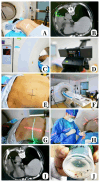Novel Laser System-Assisted CT-Guided Percutaneous Transthoracic Lung Biopsy in Patients with COPD Combined with Pulmonary Nodules
- PMID: 40672057
- PMCID: PMC12266053
- DOI: 10.2147/COPD.S530756
Novel Laser System-Assisted CT-Guided Percutaneous Transthoracic Lung Biopsy in Patients with COPD Combined with Pulmonary Nodules
Abstract
Objective: The diagnosis and management of pulmonary nodules in patients with COPD are challenging, as these nodules may represent either lung cancer or other pulmonary diseases. This study aims to evaluate the efficiency of a novel laser systems (LGS)-assisted CT-guided percutaneous lung biopsy in COPD patients with pulmonary nodules.
Methods: A retrospective analysis was conducted on the data of 60 COPD patients with pulmonary nodules. Thirty patients (n=30) underwent CT-guided percutaneous transthoracic lung biopsy assisted by LGS, while the remaining 30 (n=30) underwent conventional manual CT-guided percutaneous transthoracic lung biopsy. The surgical time, number of punctures, CT scan frequency, and complications were compared between the two groups.
Results: No significant differences were found between the two groups in terms of clinical characteristics, lesion size, location, puncture depth, or nodule nature. Compared to the traditional method, LGS-assisted CT-guided percutaneous lung biopsy significantly reduced the number of CT scans (2.3 ± 0.5 vs 3.2 ± 0.6, P < 0.001) and the average procedure time (12.6 ± 2.7 min vs 25.1 ± 3.4 min, P < 0.001). Additionally, the total intraoperative time per procedure was significantly reduced (25.1 ± 3.4 min vs 45.9 ± 8.8 min, P < 0.001). With the use of LGS, 73% (22/30) of the procedures hit the target on the first needle insertion, compared to only 6.7% (2/30) in the conventional group. Furthermore, there was no significant difference in the incidence of complications between the two groups.
Conclusion: Compared to the traditional method, the use of LGS improved puncture efficiency in COPD patients, reduced the need for needle adjustments, and effectively shortened the procedure time.
Keywords: COPD; CT; PTNB; novel laser systems; pulmonary nodules.
© 2025 Li et al.
Conflict of interest statement
The authors declare no conflicts of interest in this work.
Figures


Similar articles
-
Operational efficiency and clinical safety of laser positioning-assisted CT-guided lung nodule biopsy: A single-center retrospective cohort study.Med Phys. 2025 Sep;52(9):e18066. doi: 10.1002/mp.18066. Med Phys. 2025. PMID: 40849861
-
Efficacy and safety in synchronous core-needle biopsy and cryoablation for highly suspicious malignant pulmonary nodule.Cancer Imaging. 2025 Jun 21;25(1):78. doi: 10.1186/s40644-025-00901-0. Cancer Imaging. 2025. PMID: 40544289 Free PMC article.
-
Biopsy decision for intermediate-high-risk lung nodules is significantly changed when guided by prior positron emission tomography/CT (PET/CT) results: results of the prospective PET-FIRST study.BMJ Open Respir Res. 2025 Jun 1;12(1):e002553. doi: 10.1136/bmjresp-2024-002553. BMJ Open Respir Res. 2025. PMID: 40451293 Free PMC article.
-
Evidence for the treatment of patients with pulmonary nodules: when is it lung cancer?: ACCP evidence-based clinical practice guidelines (2nd edition).Chest. 2007 Sep;132(3 Suppl):94S-107S. doi: 10.1378/chest.07-1352. Chest. 2007. PMID: 17873163
-
Computer and mobile technology interventions for self-management in chronic obstructive pulmonary disease.Cochrane Database Syst Rev. 2017 May 23;5(5):CD011425. doi: 10.1002/14651858.CD011425.pub2. Cochrane Database Syst Rev. 2017. PMID: 28535331 Free PMC article.
References
Publication types
MeSH terms
LinkOut - more resources
Full Text Sources
Medical

